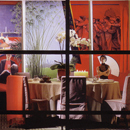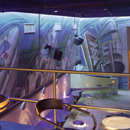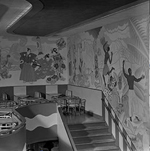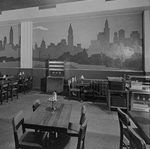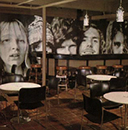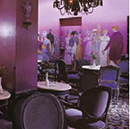
Billboard
Billboard describes a treatment for an entire planar surface as a blank canvas for art, text, graffiti or photography. In some cases Billboard encompasses more than one plane. more
Billboard | Restaurant
application
In a restaurant Billboard is used to tell stories about a restaurant's history or to convey a concept.
research
There are several subcategories of Billboard. A supergraphic is a large graphic expression covers an entire interior plane and may incorporate figurative elements, abstract geometries, and/or text.1 Supergraphic can be interpreted in three similar but different approaches: text / language, abstract geometry, and murals. In all three approaches of Billboard, artists such as surrealists and pop artists contributed to the development of this concept.
Billboard has a relatively long history as a wall treatment in restaurant settings. Geometric abstractions or murals of human figures and landscapes were more popular than text and language forms. Prior to the 1970s, the most popular type of Billboard in restaurants was natural and landscape scenes. The restaurant, Well of the Sea (1949) in Chicago, featured a mural located on the wall behind a Padded Perimeter (upholstered banquette seating). Artist Richard Koppe delineated skeletal sea creatures in sharp black against a background glowing with fluorescent paint; at night the mural was lit with black light.2
In 1960 the restaurant in the Carson, Pirie, Scott department store in Washington, D.C. replaced a large abstract art piece that acted as a focal point of the restaurant with a more realistic panorama of buildings and landscape. The mural was located above a Padded Perimeter (upholstered banquette seating) in a circular dining space. Designers imagined that the diners would imagine themselves as a part of a real landscape.
During the 1970s and 1980 decades, the subject matter of Billboard restaurants published in design trade magazines varied widely and included stylized human figures, realistic human faces, abstract forms and landscapes. The Chateau D’Vie restaurant (1973), who targeted the under-40 age groups as its clientele, commissioned Environmental Graphics to produce a Billboard of young faces in black and white. The faces are larger than life-size, and they display the popular hairstyles and caps of the time period.
For the dining area of New York Delicatessen restaurant (1983) Hirsch Bedner Associates retained an artist/muralist to depict the Busby Berkley movie era, and as an added theme, Radio City Music Hall.3The Billboard conveyed the restaurant’s theatrical theme.
As the end of the 20th century approached, abstract geometric forms emerged as the popular subject matter for Billboards. In the dining room of The Border Grill (1991) local artists created a 14-foot mural of abstract forms including the head of a howling green coyote. Using simple shapes and primary colors throughout the restaurant, the mural created a dynamic space meant to challenge the visual senses of its clientele. The Border Grill’s Billboard also matched the restaurant’s design concept.
In Rikki Rikki, “an authentic Japanese restaurant” (1991), a billboard was executed in manga, a comic book style of illustration popular in Japan. Manga was chosen to provide both an unusual graphic for wall décor and as a recognizable and entertaining element for patrons.4 The banquette wall consists of loosely sketched and painted wall with text.
With the rapid improvement of animation and cartoon industries in the 21st century, abstract drawings, photographic-quality figures, human faces and animated cartoons have become widespread reiterations of Billboard. Sometimes concise texts or language are incorporated with abstract images, and when these two forms are combined, the Billboard conveys a message about the restaurant’s beliefs, values or concepts.
In Sushi Jones Restaurant (2001) in New York City, Billboard is achieved with almost floor to ceiling padded wall panels of Xorel.5 The wall panels define a Padded Perimeter backrest to the banquette seating below.6 To achieve the design concept simple graphics are meant to convey the harmony between East and West.
Lively cartoon characters are depicted on the Billboard of MX restaurant (2006) in Hong Kong. As a casual and fast-service restaurant, the design of the dining area had to be eye-catching, but also simple. By encasing the Billboard in a lighted glass case, the graphics become reminiscent of an art object.
The restaurant business is highly susceptible to popular culture, and they are accommodating technologically savvy environments. For many years now, restaurants have incorporated television screens and advanced sound systems, and the number and size of television screens keep increasing. Nowadays restaurants install entire walls of screens (see the intype Pulsating Wall) for either entertainment or conceptual purposes. With Techno-Billboard a restaurant can send numerous messages to guests, using images, sound, movement, and texts. The use of Billboard in restaurants is limitless. From simple geometric expressions to digital messages, designers can achieve a wide-range of design solutions with cost-effective ways to redefine space.7
end notes
- 1) Elizabeth O’Brien, “Material Archetypes: Contemporary Interior Design and Theory Study”, (MA, Cornell University, 2006), 109.
- 2) “Down to the Sea in Tips,” Interiors (May 1949): 126.
- 3) Monica Geran, “Deco de Novo,” Interior Design (Oct. 1983): 202.
- 4) Judi Radice, Restaurant Deisgn 3 (Glen Cove, NY: Architecture & Interior Design Library, 1992), 162-165.
- 5) Xorel is a sustainable finish that can be used as for wallcovering, panels, upholstery. It is made of a continuous monofilament polyethelence that is durable, cleanable and colorfast.
- 6) Jen Renzi, “Clean Palette,” Interior Design (Sept. 2001): 118.
- 7) Evidence for the use and the chronological sequence of Billboard as a restaurant archetype was developed from the following sources: 1940 The Well of the Sea [1949] Robert E. Lederer; Chicago in "Down to the Sea in Tips," Interiors 10, no. 5 (May 1949): 126; PhotoCrd: Chicago Architectural Photographing Company; 1960 Safari Lounge, Paul Young's Restaurant [1961] William Pahlmann Associates; Washington, D.C in "Restaurants," Interior Design 31, no. 10 (Oct. 1960): 163; PhotoCrd: Anonymous; Heather House [1960] Carson, Pirie, Scott and Co.; Washington, D.C. in "Restaurants," Interior Design 32, no. 4 (Apr. 1961): 149; PhotoCrd: Orangaire Tea Room, National Hotel & Motel Exposition [1967] Chandler Cudlipp Associates; in Anonymous, "Restaurants: Designs for Dining," Interior Design 38, no. 10 (Oct. 1967): 152; PhotoCrd: Anonymous; 1970 Fairmont Hotel [1970] Barbra Dorn; Dallas, TX in "The New Fairmont: Merely Fabulous," Interior Design 41, no. 8 (Aug. 1970): 92; PhotoCrd: Paulus Leeser; Cooky's Steak Pubs [1971] David Laurence Roth, Interior Design; Green Acres, New Rochelle, Yonkers, NY in Anonymous, "Designing a Successful Restaurant," Interior Design 42, no. 4 (Apr. 1971): 133; PhotoCrd: Anonymous; Chateau D'Vie Restaurant [1973] Fred B. Shrallow, AID, Interior Design; Spring Valley, NY in "Five Restaurant Interiors," Interior Design 44, no. 10 (Oct. 1973): 176; PhotoCrd: Tom Hinckley; Tango [1975] Tony & Karen Barone; Chicago, IL in "Rest and Relaxation," Interior Design 46, no. 11 (Nov. 1975): 93; PhotoCrd: Alexandre Georges; The Libs [1976] Carleton Varney; New York City in "The Libs," Interior Design 47, no. 4 (Apr. 1976): 145; PhotoCrd: Richard Champion; The Grand Café [1976] Joseph Villano; New York City in "The Grand Café," Interior Design 47, no. 10 (Oct. 1976): 127; PhotoCrd: Louis Reens; Windows on the World [1977] Warren Platner Associates in New York City in "Warren Platner Associates," Interior Design 48, no. 9 (Sep. 1977): 165; PhotoCrd: Jamie Ardiles-Arce; Giorgio's [1978] Joseph Villano; New York City in "Disco Drama and Dining a la Directoire," Interior Design 49, no. 4 (Apr. 1978): 237; PhotoCrd: Jamie Ardiles-Arcee; Washington Hilton [1978] Ellen L. McCluskey Associates; Washington DC in "At the Washington Hilton," Interior Design 49, no. 7 (July 1978): 112; PhotoCrd: Jamie Ardiles-Arcee; Panache [1979] D&D Center by Design Group Ltd.; Miami, FL in "Panache," Interior Design 50, no. 1 (Jan. 1979): 219; PhotoCrd: John Stillman; 1980 Clyde's [1980] John Richards Andrews; Fairfax County, VA in Monica Geran, "Clyde's at Tysons Corner," Interior Design 51, no. 12 (Dec. 1980): 157; PhotoCrd: Mark Ross; Club A [1983] Adam Tihany; New York City in Edie Lee Cohen, "Club A," Interior Design 54, no. 3 (Mar. 1983): 214; PhotoCrd: Mark Ross; Alo Alo [1985] Adam Tihany; New York City in Edie Lee Cohen, "Alo Alo," Interior Design 56, no. 9 (Spet. 1985): 279; PhotoCrd: Peter Paige; Bolido [1989] Massimo Iosa-Ghini; New York City in Edie Lee Cohen, "Bolido," Interior Design 60, no. 6 (June 1989): 235; PhotoCrd: Peter Mauss/Esto; Beau Geste [1989] Tom Lee Ltd.; New York City in Monica Geran, "Beau Geste," Interior Design 60, no. 9 (Sep. 1989): 242; PhotoCrd: Peter Paige; 1990 Kachina Grill [1990] David Kellen Architect; Los Angeles, CA in Judi Radice, Restaurant Design 3 (Glen Cove, NY: Architecture and Interior Design Library, 1992), 98; PhotoCrd: Milroy/McAleer; Square One [1990] Andrew Belschner Joseph Vincent; San Francisco, CA in "Square One Recombinant," Interior Design 61, no. 4 (Apr. 1990): 163; PhotoCrd: John Vaughan; Remi Redux [1990] Adam Tihany; New York City in "Remi Redux," Interior Design 61, no. 9 (Sep. 1990): 185; PhotoCrd: Peter Paige; Rikki Rikki [1991] Mesher Shing and Associates; Kirkland, WA in Judi Radice, Restaurant Design 3, 164; PhotoCrd: Dick Busher; The Border Grill [1991] Maritz Architects and Ann Sheehan-Lipton Interiors; St. Louis, MI in Radice, Restaurant Design 3, 29; PhotoCrd: David W. Stradal; Eureka Restaurant [1992] Barry Design Associates; Tokyo, Japan in Radice, Restaurant Design 3, 87; PhotoCrd: Ryuzo-Tanabe; 2000 Kosushi Bar [2000] Arthur de Mattos Casaa; Sao Paulo, Brazil in Monica Geran, "Sushi e Sake," Interior Design 71, no. 8 (Jun. 2000): 164; PhotoCrd: Tuca Reines; Matsuri Restaurant [2000] Babey Moulton Jue and Booth Designers; Santiago, South America in Edie Cohen, "Sushi in Santiago," Interior Design 71, no. 12 (Oct. 2000): 204; PhotoCrd: Scott Frances; Tea Salon, Fauchon [2001] Bogdanow Partners Architects; New York City in Kelly Beamon, "Shopper Chic," Hospitality Design 23, no. 4 (May/Jun. 2001): 37; PhotoCrd: Dub Rogers; Sushi Jones [2001] Mark Oller and Victoria Kirk of MOVK; New York City in Jen Renzi, "A Clean Palette," Interior Design 72, no. 11 (Sep. 2001): 118; PhotoCrd: Mark Ross; Jones [2003] David Schefer Design; Philadelphia,PE in Stacy Shoemaker, "Happydays," Hospitality Design 25, no. 4 (May/Jun. 2003): 54; PhotoCrd: David M. Joseph; Café Zoe [2003] Tony Chi; Athens in Stacy Shoemaker, "Café Zoe," Hospitality Design 25, no. 9 (Nov. 2003): 82; PhotoCrd: George Kordakis; Ming Dynasty House [2003] Toni Chi and Associates; Shanghai, China in Monica Geran, "The Twain Shall Meet," Interior Design 74, no. 1 (Jan. 2003): 256; PhotoCrd: Doug Snower; Chlosterli [2004] Patrick Jouin; Gstaad, Switzerland in Philip Jodidio, "Chlosterli," 192, no. 4 (Apr. 2004): 142; PhotoCrd: Thomas Duval; MX [2006] Steve Leung Designers Ltd. HongKong; North Point HongKong in "Casual or Quick Service Restaurant: MX," Hospitality Design 28, no. 5 (Jul. 2006): 104; PhotoCrd: Ulso Tsang; Stand [2007] Studio Gaia; New York City in Glenn Haussman, "Back to Basics," Hospitality Design 29, no. 3 (Apr. 2007): 213; PhotoCrd: David Joseph; Katsuya Brentwood [2007] Starck Network, Paris; Los Angeles, CA in "Katsuya Brentwood," Hospitality Design 29, no. 4 (May/Jun. 2007): 166; PhotoCrd: James Merrill; Sakae [2007] The PLAN, Seoul; Busan, Korea in Stacy Shoemaker Rauren, "Gift Wrapped," Hospitality Design 29, no. 9 (Nov. 2007): 126; PhotoCrd: Yoem Seung Hoon.
bibliographic citations
1) The Interior Archetypes Research and Teaching Project, Cornell University, www.intypes.cornell.edu (accessed month & date, year).
2) Cho, Jasmin. “Theory Studies: Archetypical Practices of Contemporary Restaurant Design.” MA Thesis, Cornell University, 2009, 136-151.

